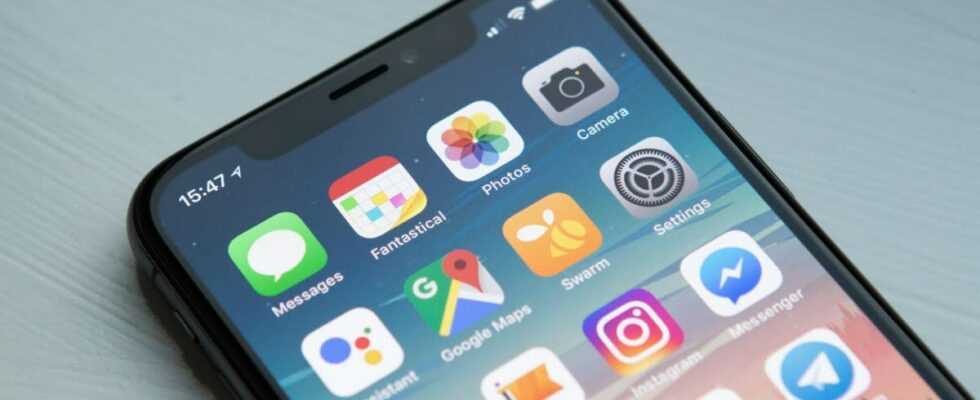In 2020, the French had spent much more time on the Internet than in 2019 because of confinements and curfews, and new habits, such as shopping in Drive or consulting medical sites and applications, had appeared in due to the pandemic. In 2021, Internet use remained at an ever-high level: 2h26 on average per day and per person, while some of these new habits were confirmed and others disappeared. Médiamétrie drew up this Thursday a table of Internet consumption by the French in 2021.
Health news continues to punctuate our use of the Internet
The pandemic remains visible in our Internet usage over the year, as we notice peaks or troughs depending on the news. The periods of confinement correspond to peaks in the time spent on the Internet: more than three hours a day in April 2021. The TousAntiCovid application and the Doctolib site both entered the top 20 of the most consulted this year. These two tools have records of consultation at the rate of government speeches, for example when the French are encouraged to be vaccinated or when the health pass is put in place.
Other tools related to the pandemic are reaching audience records according to current events, such as ViteMaDose (which is used to find a vaccination slot), when vaccination is opened to all, or the ministry’s website health during the fifth wave of Covid-19. Conversely, when confinement is lifted, the sites of places to go out such as cinemas, museums or amusement parks reach even higher levels than before the pandemic.
Habits that emerged during the pandemic remain entrenched
Teleworking and the digital tools that accompany school, which appeared strongly in 2020, remained predominant, even though classes were able to resume face-to-face.
All the information sites combined had a record audience of 22 million French people during Jean Castex’s press conference on January 14, 2021, during which he announced the implementation of the curfew. Seven out of ten French people consult news sites every month, mainly during the morning time slot, and they visit an average of nine different press brands per month. The sports sites benefited from peak audiences during the most important matches of Euro football, the Olympic Games, but also the announcement of the arrival of Lionel Messi at PSG.
The year was also a success for French Tech: there are now 26 unicorns (these start-ups valued at more than a billion dollars), compared to only three in 2017. And these unicorns attract more than 35 million unique visitors, with Doctolib in first place.
New purchasing or consumption habits
As for races, the start of the pandemic had been marked by the enormous growth of Drive, making it possible to reduce its contacts. In 2021, this use is no longer as dominant as in 2020: it has been doubled by another type of contactless purchase, home delivery. At the end of the year, 9.3 million people used it each month, compared to 7.6 million at Drive. The trend of contactless payment with a mobile application is also on the rise, and in particular the habits of pots or transfers between friends such as the French application Lydia.
In addition, some responsible or ecological consumption habits also appear in the observations of Médiamétrie, and in particular applications which offer to scan a product in a store to evaluate it according to different criteria, or even those for the purchase of anti-waste baskets food. Second-hand sales and purchase platforms are booming, but paradoxically, ultra-fast-fashion sites like Shein or Pretty Little Thing are too.
People over 50 are increasingly connected
Another notable trend of the year is the fact that people over 50 are using certain digital uses a little more than before. The time spent on the Internet by people between 50 and 64 is up 13% compared to 2020, and that of people over 65 is up 9%. This same rate is down slightly among young people, which Médiamétrie explains by the resumption of outings and face-to-face lessons. The gap between generations is therefore narrowing.
We notice the same phenomenon in the use of social networks and instant messaging: the time that people aged 50 to 64 spend there every day is up 17%, while it is down slightly among children. People over 50 are also increasingly attracted to online video games.
Continuing long-term trends
53.5 million French people connect to the Internet every month, a figure which has been constantly increasing for several years.
Our use of the Internet continues to shift more and more towards the smartphone: it represents two thirds of the time spent online and is even more popular with young people. More than 63% of them use their mobile exclusively to go on the Internet. The number of households equipped with a fixed computer has continued to decline slowly but steadily for years.
Google is still the most visited site, followed by Facebook and YouTube. Television represents 75% of the time we spend watching video content, remaining very much the majority compared to platforms such as YouTube and VOD services. In addition, the French are listening to more and more podcasts, 20% more than at the start of 2020.
The most popular social networks
Among young people, the use of social networks and messaging exceeded half of the time spent online for the first time. Facebook remains the most consulted social network in France, in number of daily users, while Snapchat is the one on which the French spend the most time. WhatsApp and Messenger also posted particularly high increases, while the use of Discord fell, neglected now that lessons are less remote.
Finally, Médiamétrie notes the rise of a new French social network, BeReal. It ranks eleventh among the social applications most used by young people. We will see next year if this application creates a surprise by climbing into the top 10 alongside the American giants.
